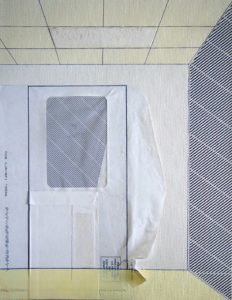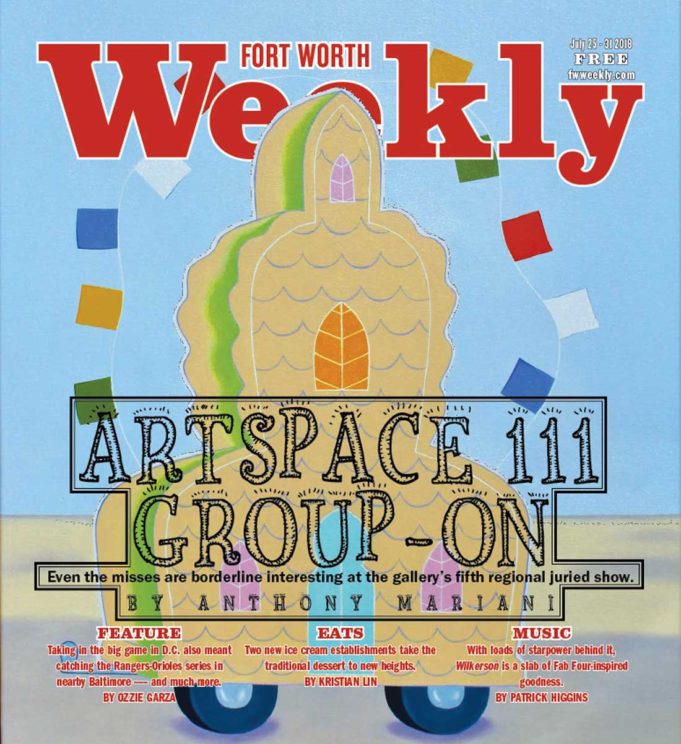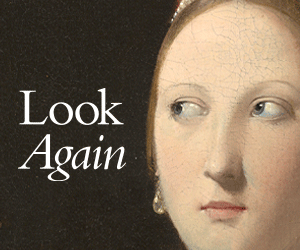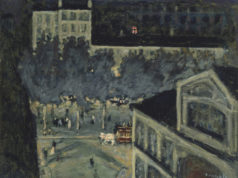It’s not just my favorite piece in Artspace 111’s fifth annual regional juried show. It’s probably one of my all-time faves. Basically, Ruth Keitz’s “Door with No View (Repetition #2)” is a business envelope sticking to a flat panel, boxed in by some dark, angular painted lines on a really wishy-washy-colored background. That’s it. I also love ’80s hair-metal and think coconut cream pie is gross, so there’s that.
I’ll skip the cliche that group shows are typically hit-and-miss affairs. I guess I just skipped it the way the Cheeto in Chief says he’s not going to insult someone on Twitter before insulting him. What you might not know about this exhibit is that our region – at least according to juror Christina Rees, editor of the Texas art blog Glasstire – digs funky materials. “Vector Artwork RGB,” “reverse Plexiglass,” “laser etched color thermal paper,” muslin, “wood enamel paint” (not “enamel wood paint”?), scratchboard, thread, “leather work gloves on panel,” neon (there are two bright and shiny examples in the show), “Dad’s hats and embroidery floss” (???), and welded bottle tops are just some of the exotic ephemera evidently doing the North Texas studio circuit. Sometimes the materials aren’t interesting enough on their own to save their pieces. Other times, they liven up otherwise ordinary subjects. Cindee Klement’s two portraits of dogs shaking themselves off, done in “walnut oil and soap bubbles,” work as both etudes and divertissements. I guess uppity paint and clay now have some competition.
Another upshot of Rees’ show is that red-state/blue-state bullshit is nearly completely absent from the walls. How in the lord’s great greenery is this practically possible?, you may marvel, considering that the amount of psychic real estate that the orange stain occupies in our minds sits in inverse proportion to his significance as a human being, and the answer is twofold: Either the only 82 people in North Texas who have never heard of a politics are who contributed to this show or Christina Rees really cares about you. Like that clean, well-lighted QuikTrip on the corner, her exhibit is a safe space, utterly bereft of anti-Trumpness — “anti-” because most visual artists and other smart people who are poor actively hate the guy. Imagine my joy upon walking into the downtown gallery from the heat of the Texas summer and the bitter, biting cold of the Twitterverse roiling in my back pocket to be greeted by mostly professional, almost uniformly nonpolitical art. This was good because I also brought my wife and sweet, innocent 6-year-old son along.
The personal may be political, and while I’m sure I can insert my pipe into my mouth and begin to read lots of us/them jabberwocky into a couple of the pieces, I can’t point it out specifically in the content. Or the form. Except for “Black Twitter.” It’s an oil painting of somebody’s timeline in which a post about the murder of Trayvon Martin floats right above one about Emmett Till. It’s not a good painting, but it is interesting.
Lillian Young’s contribution is also one of three facsimile paintings. The other two, both by Carl Smith, are of an 1120 form and a 1040. I mean, the gall. Don’t we see enough social media timelines and bureaucratic paperwork in real life? I’m still thinking about them, not angrily but curiously. Again, lots of (righteous) gall.
I’m glad I got out of my seat for the show. I was content to write about it from the cozy confines of my office. I blame Artspace 111. Their website is so good! It has jpegs of every single piece. Not to get all spiritual or whatever, but art is almost always better in person. Almost. Details can best be appreciated only in person, and as a sort of detail obsessive, I felt I owed it to at least one artist here — Meris Drew — to put myself within sniffing distance of the work. Hers chiefly but everyone else’s, too. I mention her because her contribution, “house (most fleeting of all),” is a revelation of wispy, intricate pencilwork that’s as subtly powerful as a Dvorák nocturne. Overgrown with leafy plants and shrubbery and punctuated in the distance by a star-laden shack, the landscape has the surface of an infrared photo, the bright gray of the foreground sharply contrasting with the soft night sky above. What always blows me away about this kind of outsider-ish work is the amount of time required to pull it off. Either it took Drew 20 years to finish this piece, or she doesn’t sleep or eat.
Some artworks that I wrote off onscreen look really solid in person. At Artspace111.com, Gao Hang’s “Shark VII” and “Shark VIII” are just two similar, bold, ’80s-advertising-inspired, impressionistic paintings of sharks’ heads, jaws open just enough to reveal those legendary chompers. Up close, though, the vibrant, completely unnatural hues (red on black and black on green, respectively) really sing, and the ragged brushstrokes add a sort of gritty, intellectual (as opposed to felt) realism. This is not about sharks at all. It’s about the entirety of the contemporary art world reduced to just a few simple ideas. Uniqueness isn’t always best, but it counts for a lot now, and I appreciate it.
There’s no limit on pure creativity here. Peter Harrington’s “Mahayana Recreational and Contemplative Vehicle” (see: the cover of this paper) comes from a fun place that I wish existed where spirituality has gone mobile, and Rachel Black’s photorealist painting of a brown bunny sitting on a lacy white tablecloth is simply stunning.

Clearly, I strongly disagree with the top prizewinner. Jeffrey Poole’s piece isn’t horrible. A massive canvas swarming with faint, tiny multicolor slashes in pencil and ink which form a series of tranquil horizontal lines, “Green Ice” has a sort of throwback ’70s charm. It’s minimalist yet also somehow warm and inviting. It’s probably the opposite of my favorite piece. Part of what I loved most about my 1970s childhood was analog technology. What this has to do with “Door with No View,” I’m not quite sure, but as a kid I remember sitting in the office of my dad’s interior drywall company — that he formed with just his two bare hands and English-resistant tongue and that he sunk only a couple of decades later by a series of bad investments — and just gawking at all of the cool business stuff: adding machines, blueprints, mechanical quills, staplers, staple removers, legal pads, business envelopes. There was just something about those neat, crisp manifestations of adulthood that fascinated me. “Door with No View” is my new Mariani Drywall Co.
Fifth Annual Artspace111 Regional Juried Exhibition
Thru Sat at Artspace 111, 111 Hampton St, FW. 817-692-3228.












